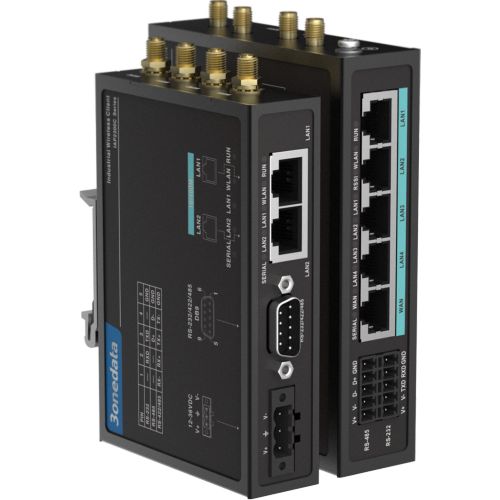
IAP2300C-2E-2T-1D-P12_36
300Mbps Dual Brand Wireless Client, 2.4G/5G,2 Port 100M RJ45,1 port 3IN1 Serial Port,12-36VDC,DIN Rail Or Wall Mounting,seamless roaming
SPEDIZIONE GRATUITA
Overview
IAP2300C series are 100M industrial wireless clients. This series have 4 products, providing 100M WAN port, 100M LAN port, 2.4G/5G dual-band antenna interface, serial port and other interfaces. This series of products provides one serial port, and supports serial port server or Modbus gateway, so that serial port devices can be equipped with networking capability immediately or realize the conversion between Modbus RTU/ASCII and Modbus TCP protocol. This series product supports DIN-Rail or wall mounting, which can meet the requirements of different scenes.
The management system supports routing, AP, bridge, client and dual link wireless work mode; Support IEEE802.11a/b/g/n wireless technology, the wireless rate of the 2E single band whole device is up to 300Mbps, the wireless rate of the 2E2E dual band whole device is up to 600Mbps. The device supports wireless encryption methods such as WPA/WPA2/WPA3 personal edition and enterprise edition, and has various security policies such as SSID hiding, wireless user isolation, IP address filtering, MAC address filtering, URL filtering, port forwarding, port redirection, ARP binding, DMZ setting, etc. Support virtual AP, that is, one AP device supports multiple SSIDs. The device supports single-band wireless fast roaming, client efficient roaming, dual-link seamless roaming. And the efficient roaming takes only about 50 milliseconds, which can meet the requirements of rapid roaming and recovery of wireless data in industrial occasions. Dual-link seamless roaming, that is, in the WLAN (Wireless Local Area Network) constituted by multiple AP, user can achieve seamless roaming without conducting the AP switching operation. In serial server mode, each serial port supports 4 TCP or UDP session connections and multiple work modes like RealCom, TCP Server, TCP Client, UDP Server, UDP Client. Under Modbus protocol mode, work modes such as RTU Master, RTU Slave, ASCII Master and ASCII Slave are supported. Up to 256 Modbus TCP Client(Master) devices can be accessed, and 128 Modbus TCP Server(Slave) devices can be connected.
The button can achieve restore factory defaults, enable debugging WLAN(2T) or restart (5T). The hardware adopts fanless, low power consumption, wide temperature, wide pressure design, through strict testing in line with industry standards, can adapt to the industrial site environment with harsh requirements for EMC, can be widely used in the robot industry: sorting robot, small freight robot, etc.
Features
- Support 2 or 5 100M copper ports, 1 RS-232/485/422 or RS-232/485 serial port (optional)
- Support optional 2.4GHz and 5GHz dual band, 2.4G single band or 5G single band, support up to 4 2.4G/5G dual band antennas to access
- Support optional wireless network modes such as routing, AP, bridge, client, and dual link mode.
- Support multiple serial port modes like RealCom, TCP Server, TCP Client, UDP Server, UDP Client
- Support conversion between Modbus RTU/ASCII and Modbus TCP protocol
- Support 12~36VDC power supply input
- Support -40~75℃ wide operating temperature range
Specifications
Standard & Protocol
IEEE 802.3 for 10Base-T
IEEE802.3u for 100Base-TX
IEEE802.11a/b/g/n for WLAN
IEEE802.11i for wireless security
IEEE802.11r for fast roaming
IEEE802.11e for WWM
Working Mode
Route mode
AP mode
Bridge mode (connection: WDS bridge, universal bridge; fast roaming)
Client mode (connection: WDS bridge, universal bridge, wireless NAT; fast roaming/efficient roaming)
Dual-link mode (connection: Dual-WDS bridge, Dual-universal bridge, Dual-wireless NAT; Seamless roaming)
Note:
Only 5T (with WAN port) devices support routing mode, AP mode, QoS management, wireless probe and other functions; Only 2E2E dual-band devices support dual-link mode.
WLAN
WAP/WAP2/WAP3 personal/enterprise edition encryption mode, hidden wireless SSID, wireless user isolation, wireless transmission power adjustment, maximum user limit, packet segmentation and RTS threshold, China/US wireless channel, WDS, WMM
Management
Intranet settings, extranet settings (routing mode/wireless NAT), wireless settings-client, wireless settings-AP, AC management, SNMP management, roaming agent, seamless roaming, QoS management, wireless probe, user settings, system upgrade, timed restart, profile management, system log, log management, wireless user list, Wi-Fi real-time traffic monitoring, serial port application, serial port log, Modbus settings
Security Policy
Wireless users: black/white list of wireless users and event notification of wireless users.
Firewall: IP filtering, MAC filtering, URL filtering, port forwarding, Port redirection, ARP binding, DMZ setting

